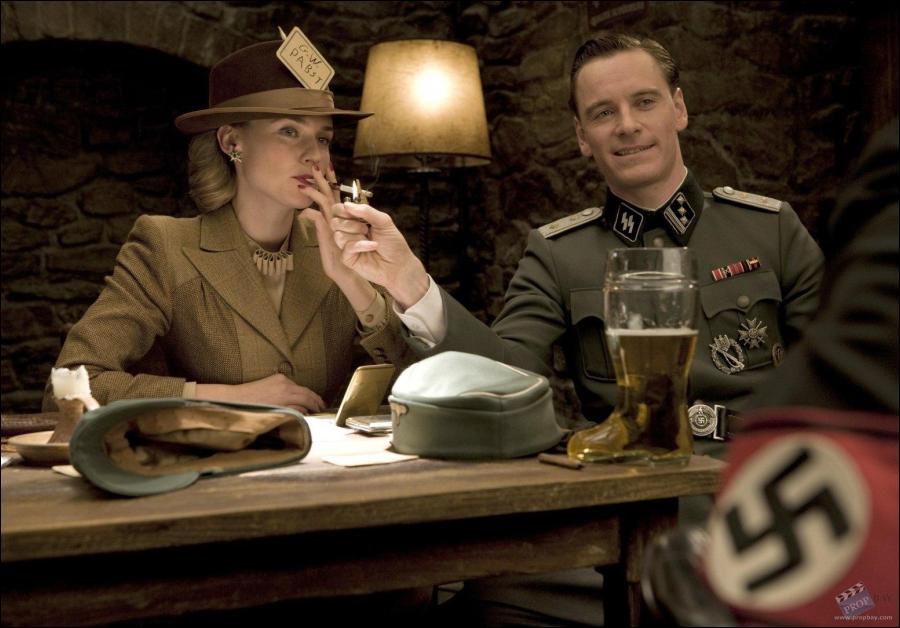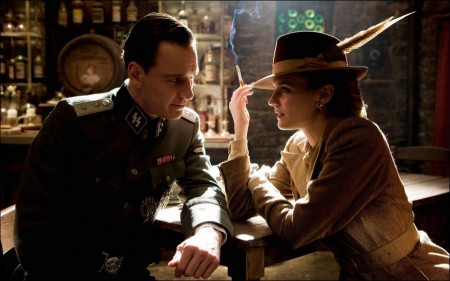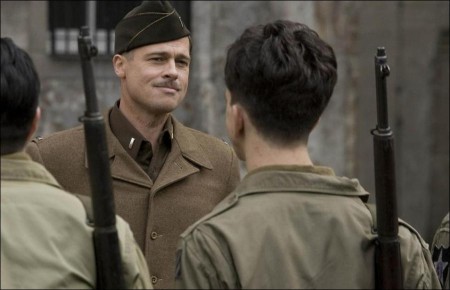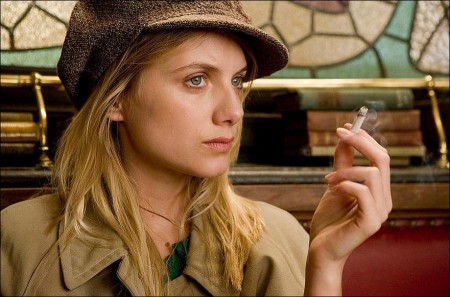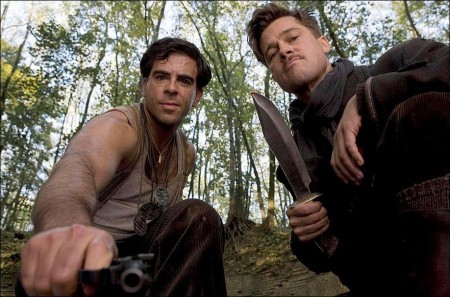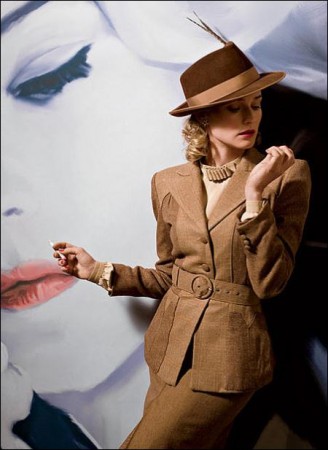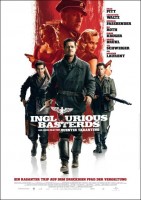Chapter One – Writing
INGLOURIOUS BASTERDS’s long gestation is best recounted via anecdotes shared by writer-director Quentin Tarantino’s friends and colleagues. Pieces of the story and elements from the script would pop up in casual conversations between Tarantino and his friends. The “men on a mission” espionage epic borrows its title from “Inglorious Bastards,” Enzo Castellari’s 1978 film.
Castelleri, who makes a small cameo in the film explains, “It’s a completely different movie, this is Quentin’s own thing, this is not a remake this is-this is something that I inspired.”
Producer Lawrence Bender recalls the first time he heard Tarantino read him pieces of INGLOURIOUS BASTERDS: “It was at least ten years ago that he was in my office, reading scenes that just blew me away. I thought, `We’ve got to make this.’” Bender would have to wait. The script went through many incarnations over the next decade. As the years passed, the title remained the same, but plot lines came and went, and Tarantino tinkered with the idea of presenting the project as a television mini-series or writing it as a novel.
Nevertheless, the oft-discussed screenplay resurfaced here and there. Eli Roth, who plays “Basterd” Donny Donowitz, recalls: “My first encounter with INGLOURIOUS BASTERDS was in December of 2004, when Quentin read and acted out the entire Hitler monologue. It was my first time seeing what I now call `Quentin Tarantino Theater,’ where he reads his screenplay and plays every character.”
Roth continues, “I remember saying that I was so completely blown away by what he had read me. For years he would call me and say, `Hey I got a new scene for INGLOURIOUS BASTERDS,’ but then he put it down to do DEATH PROOF. About a year and a half ago he said, `I really think I want to finish INGLOURIOUS BASTERDS.
In the Spring of 2008, Tarantino also mentioned to Bender that he was focusing on INGLOURIOUS BASTERDS again. “I was excited for him because he seemed happy about it,” Bender remembers. “But I didn’t realize that he was actually close to finishing it.”
On July 2, 2008, Tarantino completed the final draft of INGLOURIOUS BASTERDS. Associate producer Pilar Savone, who has worked with Tarantino since her tenure as the 2nd Assistant Director on JACKIE BROWN, remembers the moment she got her hands on the script: “We call it `publishing day’-the day that he finishes, we get the script and send it out. He put it on my desk and we made copies. He called his friends and said, `I have my script. I’ve done it. Come up and get it.’ He had a long list of people he wanted to give it to. People came in and out of the house to visit and pick up their copies. When we were almost at the end of the list I looked at all the girls in the office and I was like, `We need some wine.’”
“I got a call from him July 3rd and Pilar sent me the script,” Bender recalls. “I scratched all my plans. I stayed home, I read the script once, and I was about to pick up the phone and I said, `I’ve got to read it again.’ I sat down and read it all again. Needless to say I was pretty thrilled with it.”
Tarantino explains: “Each chapter in the movie has a vaguely different look, and a different feel, and the tone is different in all of them. The opening feels like a spaghetti western, but with WWII iconography.”
Special effects makeup artist Greg Nicotero, who has worked with Tarantino since RESERVOIR DOGS, was another early reader of the script. There was a vast difference between what he thought the film would be and what was contained in the scripts one hundred and sixty-four pages. “I was thinking that there will be giant battle scenes, and carnage, and bodies being blown apart, so it was a great surprise. I had no idea where the script was going. I was just amazed at the level of detail, and that he made it as authentic as it could be.”
Those familiar with Tarantino know his commitment to making movies for global audiences, not just for Americans. Julie Dreyfus, who starred as Sophie Fatale in KILL BILL, comments: “When he did KILL BILL he also wanted to be as authentic as possible.”
Additionally, the screenplay surprised readers because real and fictitious characters interact seamlessly in an alternate reality. “The bottom line is that the first line in the script is `Once Upon A Time in Nazi-Occupied France.’ It’s a fairy tale, and it’s a fairy tale told with Quentin’s style,” Nicotero says. “It’s a fable, and it leads you down this really unique path from the opening scene.”
An eager and enthusiastic Bender met with Tarantino on Sunday, July 6, 2008, to discuss the project and the challenges that lay ahead. Bender recalls, “We talked about the script, and then we start talking about where we shoot it. We talked about all different places around the world, and focused in on Germany and specifically in Berlin.”
Tarantino told Bender that he wanted to have the film ready for the 2009 Cannes Film Festival, a nearly impossible feat. Bender remembers: “I said, `We would have to start pre-production tomorrow, and we would have to start shooting in fourteen weeks from tomorrow. We’ll probably be in Germany before we close a deal with the financing. We’ll be casting, we’ll be crewing, finding locations, doing all that work before we even have financing.’”
Executive Producer Lloyd Phillips says, “The first 2-4 weeks were insane and everything was happening so fast. I worked around the clock dealing with time zones, crew, accounting issues etc. Because we knew we were starting on a specific date, we needed to focus everyone’s attention. Without the great team we put together, we could not have hit that date. We really had a remarkable team.”
Tarantino and the producers sent the script to Brad Pitt and started out assembling the “Basterds.”
By the time Tarantino et al arrived in Germany, production designer David Wasco had already done extensive location scouts, and he had a room filled with photographs to show Tarantino.
The frenzied, spirited pre-production schedule had begun. Fourteen weeks after “publishing day,” the Basterds were ready to roll.
Chapter Two – Casting
Casting INGLOURIOUS BASTERDS required the skill and patience of a team of casting directors in Paris, Berlin and Los Angeles. The production would cast actors from each character’s corresponding country. “I think it’s groundbreaking, but I know that the international audience is ready for it,” co-producer Henning Molfenter, who is part of the production team at placeStateBerlin’s Studio Babelsberg, says. “It’s a new step towards an international cinema, and I think it will be greatly appreciated.”
Brad Pitt was the first actor to join the ensemble cast as Lieutenant Aldo Raine. Tarantino flew to placecountry-regionFrance during pre-production to meet with the actor. Tarantino says of Pitt: “He’s wonderful. We’ve wanted to work together for a long time and this was just the right one, completely. I really didn’t consider anybody else.”
Diane Kruger, who grew up in Germany and lives in Paris, found that the multi-national cast marks a refreshing change for world cinema. “Being from Europe, I really appreciate it. I think it’s great that Quentin has the guts to do it. It adds authenticity. Different languages have different melodies, and it’s funny to hear and people not understanding each other.”
Although Bridget Von Hammersmark was among the last roles cast, Tarantino clicked with Kruger instantly. Executive Producer Erica Steinberg comments: “Diane gets Quentin’s sense of humor. When she read the script, she got him. It wasn’t something that she had to learn. She completely understands his dialogue.”
Kruger embraced her character’s place in the film’s unusual “fictitious history.” “Bridget Von Hammersmark is a very cool character to play,” Kruger says. “She is a German movie star of the 40s, in the vein of a big UFA movie star, like Marlene Dietrich or Hildegard Knef. What is special about her is that she decided to stay during the war, and she was very much loved for that by the Germans. She’s familiar with the Nazi regime, but she’s actually a spy for the Brits.”
Among the first actors cast in film was Daniel Brühl. Brühl describes the character of war-hero-turned-movie-star Fredrick Zoller: “He’s sweet and he’s handsome, and he’s a cinema lover. He has to fight hard to get Shosanna, and he does so throughout the film. He can’t take it that this girl treats him so badly and doesn’t have any respect or feelings whatsoever for him.”
Tarantino admits that Brühl’s character “is based a little bit on [well known WWII vet] Audie Murphy. And just like Audie Murphy, Daniel Brühl’s about to become a movie star.”
Brühl traveled to Paris to read with a group of French actresses who were up for the role of Shosanna. There was a palpable chemistry between Brühl and Mélanie Laurent, an actress and director who won the Golden Palm for Best Short Film at the 2008 Cannes Film Festival and the 2007 César for Most Promising Actress.
“Shosanna was always a main character,” says Tarantino. “One of the biggest changes in my conception of the film from way back when until now-in fact, hands down the biggest thing-is that, in the original version of this script, Shosanna was kind of a movie character. She was a badass. But I did that already with The Bride in `Kill Bill.’ So I started making her more like a real girl in this situation.”
Despite their initial, almost immediate successes, Tarantino remained apprehensive about finding an actor to play Col. Hans Landa. Christoph Waltz immediately set Tarantino’s mind at ease. “He starts his audition, and Quentin’s reading with him,” Bender recalls. “Quentin and I looked at each other, and I could see in his eyes, and he could see in my eyes that we found him. It was just so amazing that Quentin was so concerned, and literally hours later the guy walks in that can do it in English, French, and German. He was just killing it.”
The rest of the Basterds quickly fell in line. Til Schweiger plays Hugo Stiglitz, and had been a longtime fan of Tarantino He even named his first production company, Mr. Brown Entertainment, after Tarantino’s character in RESERVOIR DOGS.
Tarantino told Eli Roth that he had the writer-director-actor in mind for the role of Donowitz before Roth got through his draft of the script. “I was reading the final version of it, and it just blew me away. Quentin said to me, `I’m thinking that you would be really good as Donowitz.’ I figured, `Oh, it will be like DEATH PROOF, and this will be one of the guys in a small part.’ Then I read it and thought, `This is a major character. This is one of the leads in the film.’”
Joining Roth are fellow DEATH PROOF brethren Omar Doom and Michael Bacall. “It happened very late in the game,” Doom says. “Quentin didn’t decide that I was going to be a Basterd until two weeks before I had to be here. It was great surprise but very last minute.”
German actor Gedeon Burkhard, who plays Wilhelm Wicki, had been waiting years for the opportunity to be in INGLOURIOUS BASTERDS-eight years, to be exact. “We met about nine years ago in Vienna,” Burkhard recalls of his introduction to Tarantino. “I met him again in Los Angeles and he said that he was writing a WWII movie and that he was thinking of me for a part of a guy who speaks two languages and who can translate. I never heard anything again. Suddenly, I heard he was in Germany and that he was casting and basically I was sitting around, nervously waiting to see if I would be called to the auditions. I finally did, and I went to the audition, got the part and I’ve been smiling ever since.”
B.J. Novak, who produces, writes and stars on NBC’s THE OFFICE, took a break from the television show to play the role of Smithson Utivitch. “We had to work out the scheduling [with the show], but everyone knew that this was not just a job for me,” Novak says. “They knew that this was a dream and an experience, so they went the extra mile to make it work.”
A physical distinction almost got in the way of winning the part; Novak wasn’t the shortest of the auditioning Basterds, but his character is described as “The Little Man.” “Quentin said, `You know you might not be small enough to play Utivich,’ which was a very bittersweet compliment. On THE OFFICE, “everyone’s like six-foot-five, and they all tease me for being the point guard of the group. And now Quentin was telling me that I was too tall for something I really wanted. I think Utivich’s attitude fit really well for me, so that was the part I ended up getting.”
Rounding out the Basterds are comedian, writer and actor Paul Rust and Samm Levine. Says Basterd Eli Roth, “The idea is that you hear these stories about the Basterds and you expect these monsters, these huge, dangerous guys, and basically it’s my class from Hebrew school.”
Tarantino wasted no time getting the boys excited to become “Basterds.” He told them all: “The Basterds are acting like Apaches in a no-win situation. That’s what they’re trying to do. They’re trying to win a psychological, guerilla war against the Nazis.”
As the Basterds were being cast, actors were chosen for the two major French roles. “Denis Menochet was the first guy to audition for the part,” Bender says of the actor who won the part of Perrier Lapadite. “He is such a strong actor and although he doesn’t have a lot of words, his eyes say it all. His scene with Christoph Waltz, who plays Colonel Landa, is powerful.”
The other French role of Marcel went to Jacky Ido, Shosanna’s confidante. “Marcel is this character who’s seeking for purity in the world that has been completely spoiled.” Ido says of his character, adding that Marcel and Shosanna share an objective: “Together, they’re trying to reestablish some purity.”
Irish actor Michael Fassbender was tapped to play British cinema expert Archie Hicox. Again, there was a need for the actor playing the character to be bilingual. Fassbender had to brush up on his long-dormant German language skills. “My father is German. We left there when I was two, but we used to go back and forth when I was little,” Fassbender explains. “I think I was about six where I spent a summer in Germany, and a few things managed to sort of cement in there. I just had to reawaken them with a stick.”
Fassbender explains his character Hicox, “Hicox is a British commando, but his real passion lies in films. He’s a film critic, but the fact that he can speak German makes him quite a good tool for the British.
Starring in a pivotal scene with Michael Fassbender are Mike Myers and Rod Taylor. “He (Meyers) is a huge WWII buff and he wanted to be part of the movie. Quentin and he got on the phone and were totally in sync on this character, Fenech,” Steinberg says of Myers. “When Mike got here, he went through like hair and makeup and prosthetics and by the time I saw him on set I had no idea who it was.”
Sylvester Groth played Goebbels before in Dani Levy’s “Mein Führer.” “It’s quite exhausting to play this character because he’s from moment to moment he changes, and you can never quite grab him. It’s impossible, and that’s great. For an actor, that’s fantastic. But you have to be very awake and able to jump from here to there at the moment, just change.”
German actor August Diehl plays Major Hellstrom. “I think that Hellstrom is somebody who wants to be like Landa. He’s a little bit angry about his career. Hellstrom sees `La Louisiane’ as a big chance and as a new story for him.”
Julie Dreyfus nabbed the role of Francesca Modina. “Quentin wrote this part for her,” Savone says of the role of Francesca Mondino, which was tailor-made for Dreyfus. “She was Francesca from day one. She’s always the one who’s the most nervous, and she needs to know her lines, and she needs to get her translation, and she works really hard, and she comes on set, and Quentin gives her a hard time because she’s family.”
INGLOURIOUS BASTERDS allowed some actors who had worked with each other previously to reunite. Daniel Brühl and August Diehl, two of Germany’s most widely-regarded young actors, met in 2004 on the set of the film LOVE IN THOUGHTS, and have remained close friends in the years since. “We have two scenes together in this movie, and we have always fun together,” Diehl says. “Daniel is very funny and a very special guy.”
Kruger, whose first day on set involved Pitt hoisting her bloodied body onto a veterinarian’s observation table, starred with Pitt in TROY. “It’s fun to see Brad again. We really didn’t have any scenes together in TROY. A couple of years have passed and I think I evolved as an actress. It’s fun to work together.”
The director and Pitt had a certain rapport with each other as well. “They were like two peas in a pod,” Bender recalls. “The thing that was great about Brad was he always played Aldo Raine. He was always playing that character on the set. It was fun to watch. He’s a terrific guy. You could see that Quentin really respected and enjoyed directing him and working with him. They made a great combination.”
Tarantino agreed. He loved working with Brad, offering, “He doesn’t really break character. When you talk to him about other stuff, he talks in Aldo’s voice. And because I created the character, it’s great to have the guy around all the time.”
Once casting was complete, Quentin got the cast together for a large table read. He explained to the room that all WWII films fall into two categories-war-as-tragedy films and men-on-the-move films. “He said we’d all definitely be making a men-on-the-move movie,” says “Basterd” B.J. Novak.
Chapter Three – Crew Preparations
With little time to prepare, costume designer Anna Sheppard, production designer David Wasco and special effects makeup artist Greg Nicotero spent the weeks prior to production testing, building and creating at a feverish pace.
Sheppard added another dimension to the alternate world of INGLOURIOUS BASTERDS with her imaginative, inventive costumes. Sheppard was hesitant to take on another WWII-era project, having designed the costumes for HBO’s BAND OF BROTHERS, Polanski’s THE PIANIST, and Spielberg’s SCHINDLER’S LIST. Once she read the script, however, Sheppard realized that INGLOURIOUS BASTERDS would offer her an opportunity to look at the era in a completely unexpected way.
“I felt that I was given a lot of freedom and that gave me courage to try new things, and to try a new approach,” Sheppard says. “I really enjoyed doing a movie from this period like never before. Maybe doing the other ones made me confident about this period, but also it gave me great joy to see how appreciated my costumes were.”
Kruger, for one, enthuses that the suit worn in the “La Louisiane” sequence matched her character’s personality perfectly: “She doesn’t want to be recognized or draw attention to herself, but she’s a movie star, so she has this fedora with a feather, and this perfectly tailored suit. It’s very funny that anyone would think you could go unnoticed in such a beautiful suit.”
Sheppard found her meeting with Dreyfus to be a major source of inspiration. “Julie is very beautiful, and she knows how to carry clothes. She’s always wearing something like animal fur, or a funny bag with the alligator on it, or a leopard hat. It’s always something cruel with Francesca (Mondino).”
Dreyfus explains of Mondino’s relationship with Goebbels-and clothing. “She’s a wonderfully well-dressed character. She struts around in these beautiful dresses, and furs, and jewels, which for me is fantastic. I’ve never been able to wear such amazing stuff! Anna crafted everything the same way they did it in Hollywood in the old days.”
“When you put this stuff on it just gets you into the role,” Roth says of Sheppard’s costumes. “I thought she did such a wonderful job of giving everyone their own diverse look while keeping them in the same universe.”
“I really saw it in the finale sequence,” Roth adds. “She has so many different colors, different styles, and they all live together in the same world. They are all definitely Nazi officers, but she was able to use the color palette of the movie to put it into each character. You felt like everyone is a distinct character. You look at the clothes and you see the each character’s history.”
The makeup designs for Winston Churchill, Adolph Hitler, and Joseph Goebbels offered unusual challenges and rewards for makeup artist Greg Nicotero and his team. In his first meetings with Tarantino, Nicotero showed images of Goebbels alongside pictures of Groth and discuss what enhancements needed to be made to the actor.
“Martin Wuttke, who plays Adolph Hitler, had only played Hitler on stage, so he had never gone through the prosthetics process,” Nicotero says. “For his makeup test, we had silicone cheeks, and a chin, and nose, a wig, and contact lenses, and it was fascinating to watch him look at the transformation. He was so accustomed to playing this character but he didn’t look like him.”
“Emanuel Millar, the hair department head, styled all the wigs, and was an integral part of our team because he utilized the designs that we had and brought all those characters to life,” Nicotero adds.
Mike Myers, who has worn prosthetics for his entire career, was eager to meet with the makeup artist to design the look for General Fenech. “He’s really accustomed to it, and he has a lot to say about what his character looks like. He really wanted to be an integral part of the character design. Mike really wanted to do a couple of make-up tests just so he could start finding who Fenech was.”
Production designer David Wasco, who travelled to Berlin to begin location scouting almost immediately after Bender and Tarantino’s July meeting, assembled his department quickly. “Berlin is a very busy city for making movies, but I arrived as some things were finishing. I ended up with an all-German art department-all from Berlin. I believe this is the first movie of this size that has used an all-local team.”
Wasco relished the chance to do a period movie with Tarantino “We tried to make a few of his other projects kind of nebulous period movies. For RESERVOIR DOGS, we evoked the 70’s and the same with PULP FICTION, so that they would be pretty timeless. This one is late 1930’s, early 1940’s and we set out to be very accurate,” Wasco says.
Wasco says that Laurent’s movie theater in the film is based on a few theaters in California. Tarantino asked Wasco to look closely at several theaters, including the Vista Cinema in Silverlake. The design team also managed to find two matching vintage carbon-arc film projectors that really worked. The cast and crew all were amazed watching the antiques play real nitrate film stock-it was a first for everyone.
In addition to the preproduction preparations made by the crew, Laurent and Roth had to learn trades to better portray their characters.
In the weeks prior to shooting her cinema scenes, Tarantino sent Laurent to Los Angeles for film projection boot camp at the New Beverly Cinema in order to better portray a projectionist. “The test was to project RESERVOIR DOGS,” says Laurent. “We showed a lot of cartoons and trailers before the movie. The audience didn’t know it was me with the machine. So it was just amazing. This was during three hours: midnight to 3:00 AM, and it was just amazing. And I was alone with all the machines, and the shows did go on and I did it with pride.”
Chapter Four – Location
After a ten-year writing period and a fourteen-week pre-production, filming of INGLOURIOUS BASTERDS began on October 9, 2008 in the small German town of Bad Schandau, near the Czech border. The film was shot almost entirely in sequence, beginning with the terrifying standoff between Perrier Lapadite and Hans Landa at the Lapadite Farm. The location was chosen for the rolling landscape and the unusual presence of buttes, which are also characteristic of the topography of the American West.
The Lapadite Farm interior, the cinema interior, and the “La Louisiane” interior were all built on stages at Berlin’s Studio Babelsberg. The ninety-seven-year-old studio was home to UFA (Universum Film AG), the studio behind many of Germany’s most famous films. The studio enjoyed a rebirth in the mid-1990s, when stages were refurbished and new buildings were erected. Slowly, the studio became the hub of European film production. In 2000, THE PIANIST, which was filmed at Babelsberg, won three Oscars. Notable productions like THE CONSTANT GARDENER, THE BOURNE SUPREMACY, THE COUNTERFEITERS and THE READER followed.
Shosanna’s theater was also recreated at Babelsberg. Both the Los Angeles Theater and the Vista Theater were inspiration for the resulting space with a modernistic, Deco look which was en-vogue in the 30’s. “We morphed it all together, but we were doing a French cinema. The exterior was constructed on Babelsberg’s back lot, and the lobby and interior were created on the Marlene Dietrich stage. A duplicate of the stage was also created at an abandoned cement factory an hour outside of Berlin.
“Babelsberg is an exciting place for filmmakers. We offer wide range of services from stage construction to prop rental but also to co-productions and investment opportunities for filmmakers,” co-producer Henning Molfenter says of the facility.
Following their time at the Lapadite Farm, the production relocated to Berlin. “I first got to Berlin and checked out all of the sites from the war which are all still intact. There are still bullet holes in the walls of buildings. You can still see remnants of the war everywhere. Some of the places that we used as locations were real Nazi forts that Hitler built,” Doom says of his experience in the city.
We see The Basterds in action in a wooded area that was part of Fort Hahneberg, which was built in 1888 but never actually used. The space was closed after WWII and reopened in 1990. The overgrown, wooded ravine was the perfect setting for the Basterds to confront their enemies and make good on the “one hundred scalp promise” that gains the Basterds their reputation.
Laurent, Brühl and the crew traveled to Paris to shoot a small scene in a French Bistro just before the production took a break for the holidays.
“One of our references for the search was a Claude Chabrol movie called THE BLOOD OF OTHERS, which Quentin had us look at. Well we ended up finding the location that the director used for that movie, and that was the clincher. It was a homage to Claude Chabrol.”
“I must say I was very happy to be part of the only scene shot in Paris,” Brühl says. “You can tell that it’s real-that it’s not a movie set. It’s one of the most beautiful cities I know in the world. The atmosphere was just great because it was before the Christmas break so everybody was happy to be there for a couple of days. And the food was excellent. The French catering was spectacular.”
On the heels of that very cool party, the crew parted ways for the holidays and reconvened in 2009 for the film’s breathtaking fifth and final chapter.
Chapter Five – Filming
“We shot in these extraordinary stages that have all this history,” Bender says of the studio where METROPOLIS and THE BLUE ANGEL were filmed. “The films of Hitler’s period shot there as well, so it has a weird, interesting energy. We’re shooting right where Goebbels shot his movies.”
The “men on the mission” find themselves brutally re-routed when a story about scalping fascists ultimately dovetails into an international espionage plot to take down The Third Reich. This shift takes place in the intense “La Louisiane” sequence. The actors occupied the tiny space for three weeks after two and a half weeks of rehearsals.
Everyone knew that sequence would be memorable. Tarantino says, “The `La Louisiane’ scene is like a reduced version of RESERVOIR DOGS, but with Nazis and Germans, but instead of that warehouse, they’re in a basement bar.” He knew rehearsing the sequence was the best way to be ready when the cameras were ready to roll.
“By the time we got to shoot the scene, it felt like we were in a play,” Kruger remembers. “I knew my lines. I dreamt about my lines. I could have said them in my sleep. Everything was in place. One of the things that makes Quentin a great director is that even when you’re just in the background, he watches you. You know you can’t get away with anything, and you don’t want to because you know as an actor he appreciates what you’re doing. You know he sees everything. You never as an actor feel underestimated or not appreciated.”
“`La Louisiane’ is hopefully going to be one of the biggest scenes of the movie,” says Kruger. “It’s when Brad and my storyline really takes off. You’ve seen him, and you’ve followed Shosanna, and you know what she’s planning, and then `La Louisiane’ makes the movie all come together. You know the master plan, but it falls apart and we have to come up with Plan B.”
B.J. Novak recounts, “Maybe the coolest night for me filming we shot in this truck, a scene where Brad and I were kidnapped, in handcuffs with bags over our heads. It was just an establishing shot. I showed up and all I had to do was be handcuffed and have this bag over my head. Brad Pitt is there in his white tuxedo jacket, and Quentin Tarantino, my all time hero is there behind the camera, and I realized there’s no way I can mess this up. I have a bag over my head, I’m handcuffed, I have no lines, there’s nothing I can do to mess this scene up. I just kinda looked around between every take and just marveled at my good luck. It was the most glamorous thing. I mean not only Brad Pitt, but like in a white tuxedo, and a moustache, and an accent, hamming it up and absolutely convincing, and taking you back to the 40’s. It was the most transformative film experience that I couldn’t mess up. I kept thinking `I can’t believe I’m here.’”
Much of the film’s final sequence required the expertise of stunt coordinators Jeff Dashnaw and Bud Davis, who worked with 160 stunt people from throughout Europe. The team had one set at Babelsberg, then a second “burn” set that was in an abandoned cement factory that was literally charred. Well over one hundred stunt people were “running” out of a burning building in a mass exodus, crowding and stepping over each other.
Quentin always said “the less, VFX the better.” So they turned to a pro stunt coordinator, Jeff Dashnaw. He explains, “I’d like to say I don’t get nervous about fire, but fire to me is the ultimate danger in our business because, as far as I’m concerned, there’s not a small accident when you’re working with fire. If there’s an accident, it’s a big accident.”
Omar and Eli actually shot their own stunts in the sequence. “Quentin wants everything to look and feel and be as real as possible” says Eli. “When you see fire, that is fire. He wants it to feel organic. I think that’s part of what makes the film work. It takes the best people to know how to do that safely and still make it convincing, and really sell it. Jeff Dashnaw is incredible that way.”
A film within a film… The surprise short-within-the-film is the mock propaganda film called “Nation’s Pride.” Shot by Eli Roth and his brother Gabriel, “Nation’s Pride” stars Daniel Brühl. The short had about 120 set-ups and runs about seven minutes in length in total, though is it not all featured in the finished film. Says Brühl “I think that this film is hopefully going to be a feature on the DVD so that there’s a chance to see it-the whole film because really good.” Roth laughs, “He’s got the Jewish director to make the Nazi propaganda.”
Epilogue
“Once upon a time in Nazi occupied Germany…” “It’s obviously not a documentary,” says Diane Kruger. “The film is about a group of rebels who decide they want pay back. I love it.”
Roth adds some adrenaline. “It’s like a Quentin Tarantino movie on steroids and speed. It’s a movie that takes place in WWII, but this is not a WWII movie. This is a fast, exciting, tense, with all the thrills, all the tension, all the shoot-out, all the violence you’d expect from a Tarantino film but with a subject matter like you’ve never seen it before.”
It is a revenge movie about both revenge and the movies. B.J. Novak says, “all of Quentin’s films have always been romantic to me. This one especially. It’s his most romantic story because it’s about cinema saving the world. It’s about a very romantic idea. Romantic and brilliant.”
Quentin Tarantino’s favorite aspect of the film? Naturally: “I like that it’s the power of the cinema that fights the Nazis,” he says. “But not just as a metaphor, as a literal reality.”
Production notes provided by Universal Pictures.
Inglourious Basterds
Starring: Brad Pitt, Diane Kruger, Melanie Laurent, Christoph Waltz, Daniel Bruhl, Eli Roth, Samm Levine, B.J. Novak, Til Schweiger, Gedeon Burkhard, Paul Rust
Directed by: Quentin Tarantino
Screenplay by: Quentin Tarantino
Release Date: August 21, 2009
MPAA Rating: R for strong graphic violence, language, brief sexuality.
Studio: Universal Pictures
Box Office Totals
Domestic: $111,737,535 (48.9%)
Foreign: $116,555,935 (51.1%)
Total: $228,293,470 (Worldwide)
